Samsung Mobile's Global Marketing Strategy and Indian Market Plan
VerifiedAdded on 2023/05/31
|14
|4610
|205
Report
AI Summary
This report presents a global marketing strategy and plan for Samsung Mobile's expansion into the Indian market. It begins with an introduction to the context and assumptions made, including a SWOT analysis that identifies strengths, weaknesses, opportunities, and threats. The report then outlines specific marketing objectives, focusing on launching a new product and penetrating the Indian market. It details the steps involved in both, including market definition, analysis, and entry options like direct investment. The target market is defined using demographic, psychographic, and behavioral segmentation, with a focus on young, tech-savvy consumers and those interested in superior camera features. The report also considers the competitive landscape and emphasizes the importance of a well-defined marketing mix to achieve success in the Indian smartphone market.
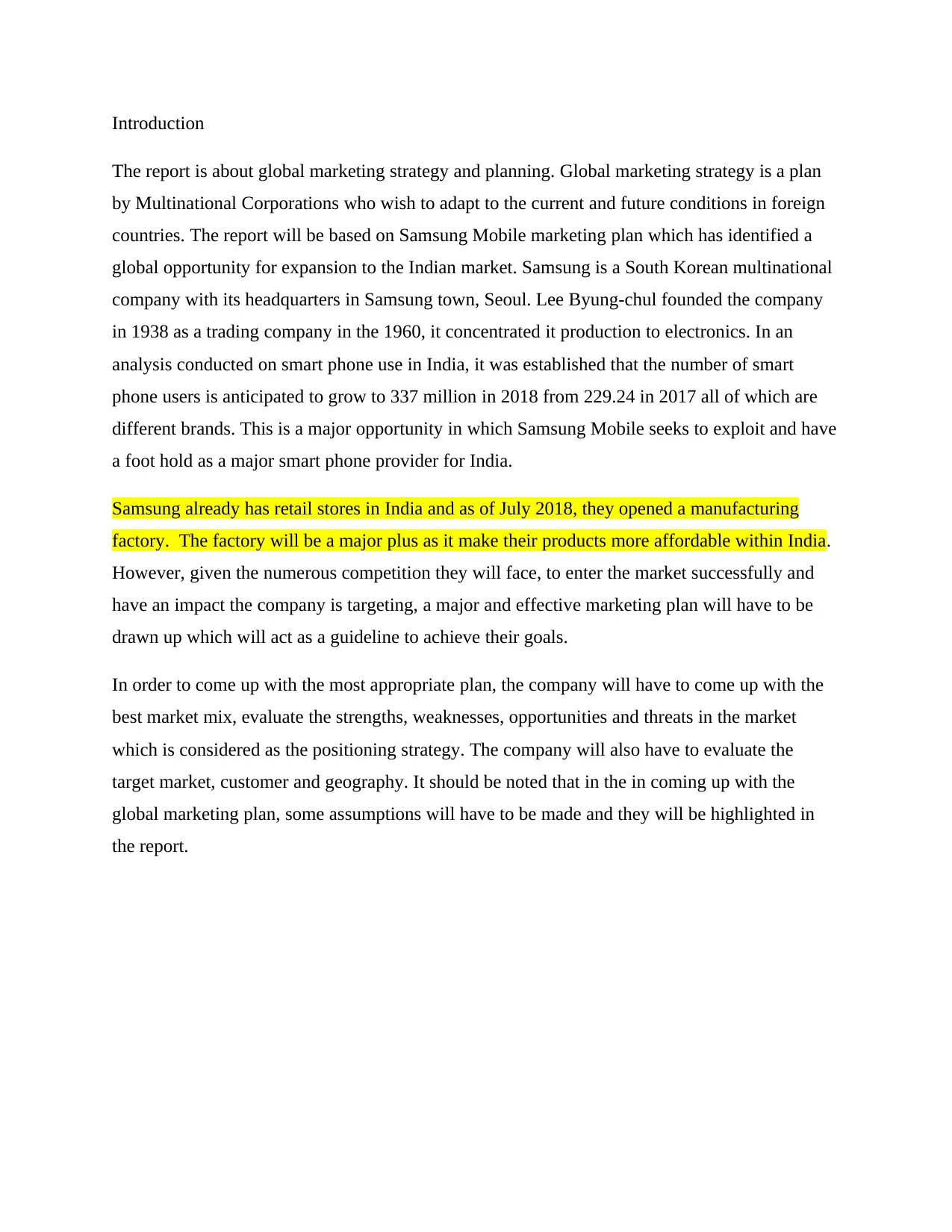
Introduction
The report is about global marketing strategy and planning. Global marketing strategy is a plan
by Multinational Corporations who wish to adapt to the current and future conditions in foreign
countries. The report will be based on Samsung Mobile marketing plan which has identified a
global opportunity for expansion to the Indian market. Samsung is a South Korean multinational
company with its headquarters in Samsung town, Seoul. Lee Byung-chul founded the company
in 1938 as a trading company in the 1960, it concentrated it production to electronics. In an
analysis conducted on smart phone use in India, it was established that the number of smart
phone users is anticipated to grow to 337 million in 2018 from 229.24 in 2017 all of which are
different brands. This is a major opportunity in which Samsung Mobile seeks to exploit and have
a foot hold as a major smart phone provider for India.
Samsung already has retail stores in India and as of July 2018, they opened a manufacturing
factory. The factory will be a major plus as it make their products more affordable within India.
However, given the numerous competition they will face, to enter the market successfully and
have an impact the company is targeting, a major and effective marketing plan will have to be
drawn up which will act as a guideline to achieve their goals.
In order to come up with the most appropriate plan, the company will have to come up with the
best market mix, evaluate the strengths, weaknesses, opportunities and threats in the market
which is considered as the positioning strategy. The company will also have to evaluate the
target market, customer and geography. It should be noted that in the in coming up with the
global marketing plan, some assumptions will have to be made and they will be highlighted in
the report.
The report is about global marketing strategy and planning. Global marketing strategy is a plan
by Multinational Corporations who wish to adapt to the current and future conditions in foreign
countries. The report will be based on Samsung Mobile marketing plan which has identified a
global opportunity for expansion to the Indian market. Samsung is a South Korean multinational
company with its headquarters in Samsung town, Seoul. Lee Byung-chul founded the company
in 1938 as a trading company in the 1960, it concentrated it production to electronics. In an
analysis conducted on smart phone use in India, it was established that the number of smart
phone users is anticipated to grow to 337 million in 2018 from 229.24 in 2017 all of which are
different brands. This is a major opportunity in which Samsung Mobile seeks to exploit and have
a foot hold as a major smart phone provider for India.
Samsung already has retail stores in India and as of July 2018, they opened a manufacturing
factory. The factory will be a major plus as it make their products more affordable within India.
However, given the numerous competition they will face, to enter the market successfully and
have an impact the company is targeting, a major and effective marketing plan will have to be
drawn up which will act as a guideline to achieve their goals.
In order to come up with the most appropriate plan, the company will have to come up with the
best market mix, evaluate the strengths, weaknesses, opportunities and threats in the market
which is considered as the positioning strategy. The company will also have to evaluate the
target market, customer and geography. It should be noted that in the in coming up with the
global marketing plan, some assumptions will have to be made and they will be highlighted in
the report.
Paraphrase This Document
Need a fresh take? Get an instant paraphrase of this document with our AI Paraphraser
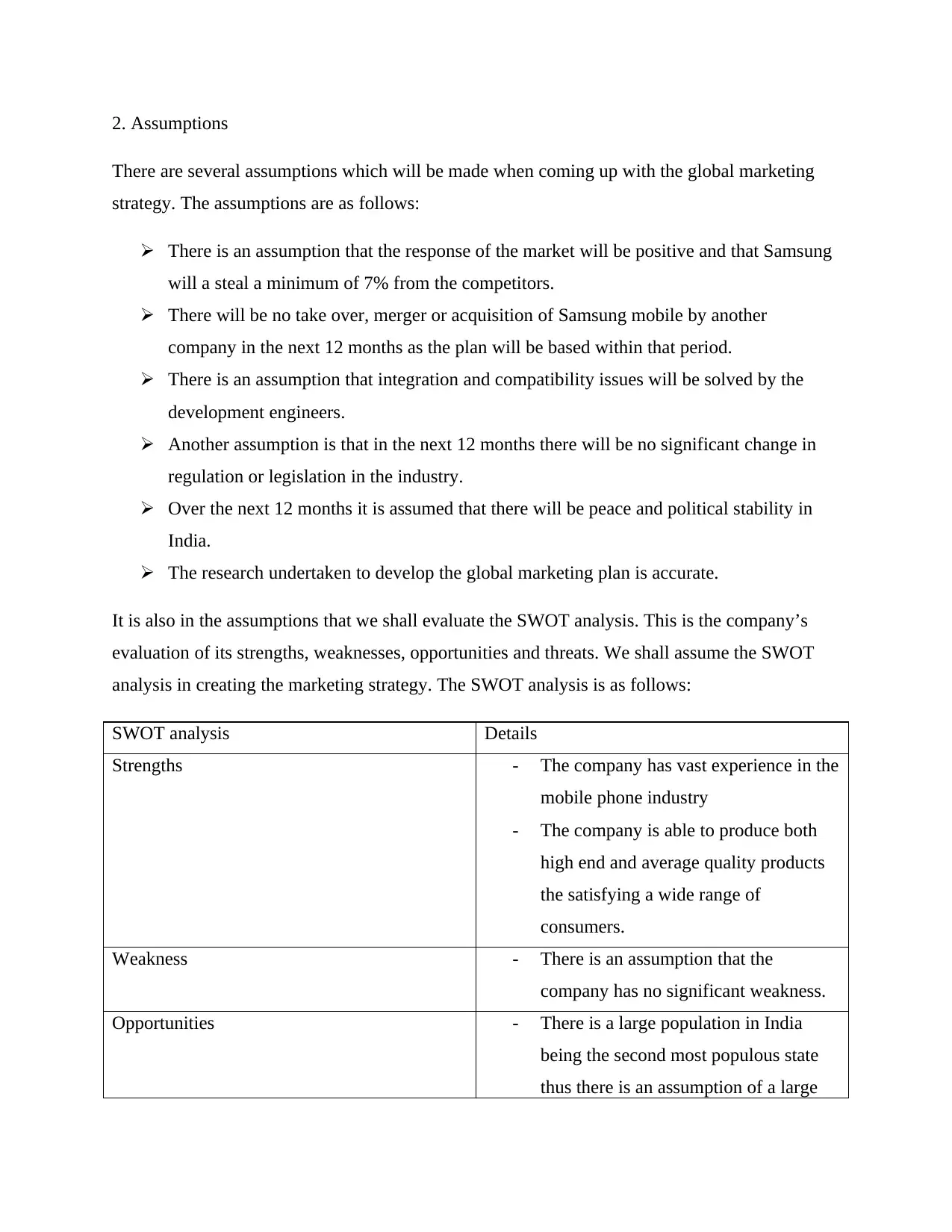
2. Assumptions
There are several assumptions which will be made when coming up with the global marketing
strategy. The assumptions are as follows:
There is an assumption that the response of the market will be positive and that Samsung
will a steal a minimum of 7% from the competitors.
There will be no take over, merger or acquisition of Samsung mobile by another
company in the next 12 months as the plan will be based within that period.
There is an assumption that integration and compatibility issues will be solved by the
development engineers.
Another assumption is that in the next 12 months there will be no significant change in
regulation or legislation in the industry.
Over the next 12 months it is assumed that there will be peace and political stability in
India.
The research undertaken to develop the global marketing plan is accurate.
It is also in the assumptions that we shall evaluate the SWOT analysis. This is the company’s
evaluation of its strengths, weaknesses, opportunities and threats. We shall assume the SWOT
analysis in creating the marketing strategy. The SWOT analysis is as follows:
SWOT analysis Details
Strengths - The company has vast experience in the
mobile phone industry
- The company is able to produce both
high end and average quality products
the satisfying a wide range of
consumers.
Weakness - There is an assumption that the
company has no significant weakness.
Opportunities - There is a large population in India
being the second most populous state
thus there is an assumption of a large
There are several assumptions which will be made when coming up with the global marketing
strategy. The assumptions are as follows:
There is an assumption that the response of the market will be positive and that Samsung
will a steal a minimum of 7% from the competitors.
There will be no take over, merger or acquisition of Samsung mobile by another
company in the next 12 months as the plan will be based within that period.
There is an assumption that integration and compatibility issues will be solved by the
development engineers.
Another assumption is that in the next 12 months there will be no significant change in
regulation or legislation in the industry.
Over the next 12 months it is assumed that there will be peace and political stability in
India.
The research undertaken to develop the global marketing plan is accurate.
It is also in the assumptions that we shall evaluate the SWOT analysis. This is the company’s
evaluation of its strengths, weaknesses, opportunities and threats. We shall assume the SWOT
analysis in creating the marketing strategy. The SWOT analysis is as follows:
SWOT analysis Details
Strengths - The company has vast experience in the
mobile phone industry
- The company is able to produce both
high end and average quality products
the satisfying a wide range of
consumers.
Weakness - There is an assumption that the
company has no significant weakness.
Opportunities - There is a large population in India
being the second most populous state
thus there is an assumption of a large
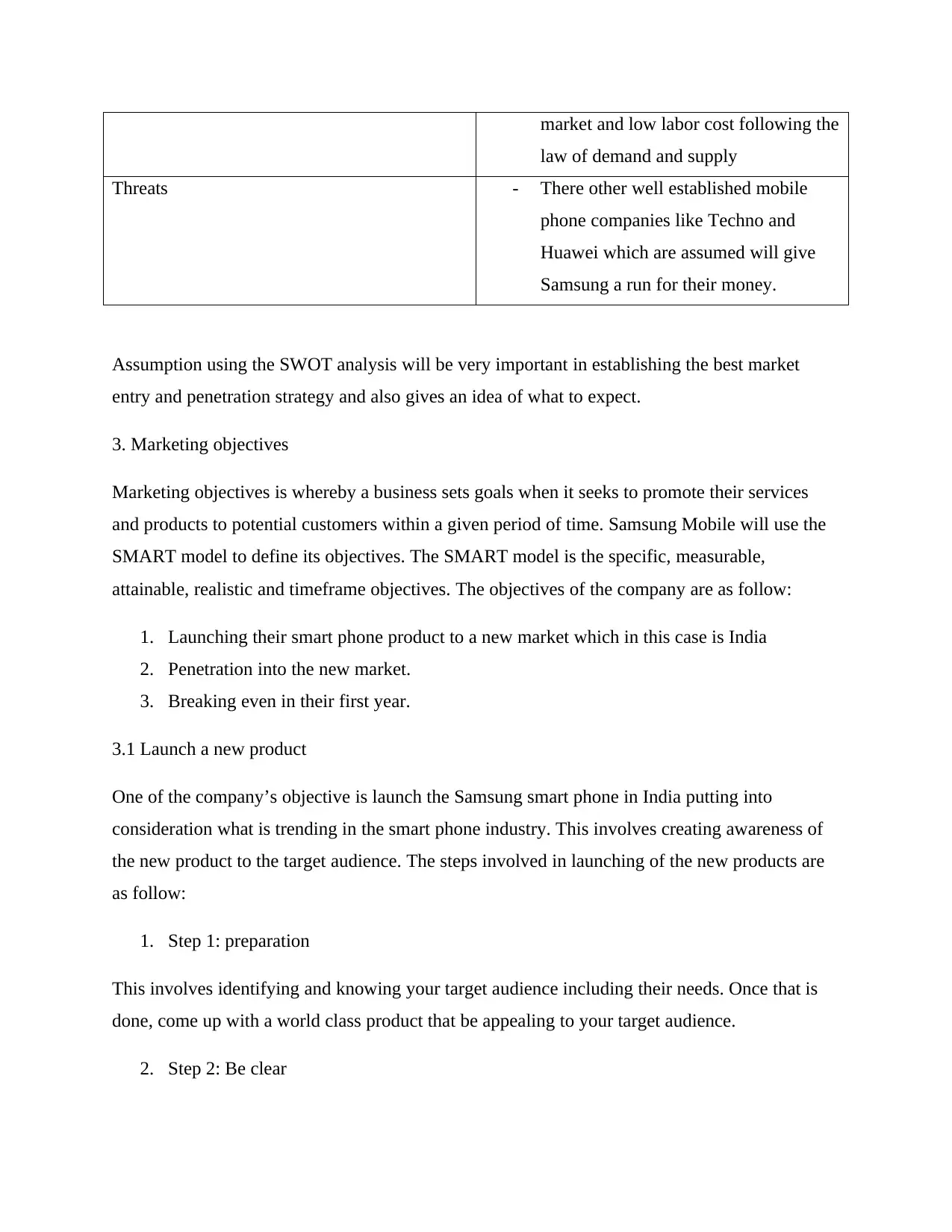
market and low labor cost following the
law of demand and supply
Threats - There other well established mobile
phone companies like Techno and
Huawei which are assumed will give
Samsung a run for their money.
Assumption using the SWOT analysis will be very important in establishing the best market
entry and penetration strategy and also gives an idea of what to expect.
3. Marketing objectives
Marketing objectives is whereby a business sets goals when it seeks to promote their services
and products to potential customers within a given period of time. Samsung Mobile will use the
SMART model to define its objectives. The SMART model is the specific, measurable,
attainable, realistic and timeframe objectives. The objectives of the company are as follow:
1. Launching their smart phone product to a new market which in this case is India
2. Penetration into the new market.
3. Breaking even in their first year.
3.1 Launch a new product
One of the company’s objective is launch the Samsung smart phone in India putting into
consideration what is trending in the smart phone industry. This involves creating awareness of
the new product to the target audience. The steps involved in launching of the new products are
as follow:
1. Step 1: preparation
This involves identifying and knowing your target audience including their needs. Once that is
done, come up with a world class product that be appealing to your target audience.
2. Step 2: Be clear
law of demand and supply
Threats - There other well established mobile
phone companies like Techno and
Huawei which are assumed will give
Samsung a run for their money.
Assumption using the SWOT analysis will be very important in establishing the best market
entry and penetration strategy and also gives an idea of what to expect.
3. Marketing objectives
Marketing objectives is whereby a business sets goals when it seeks to promote their services
and products to potential customers within a given period of time. Samsung Mobile will use the
SMART model to define its objectives. The SMART model is the specific, measurable,
attainable, realistic and timeframe objectives. The objectives of the company are as follow:
1. Launching their smart phone product to a new market which in this case is India
2. Penetration into the new market.
3. Breaking even in their first year.
3.1 Launch a new product
One of the company’s objective is launch the Samsung smart phone in India putting into
consideration what is trending in the smart phone industry. This involves creating awareness of
the new product to the target audience. The steps involved in launching of the new products are
as follow:
1. Step 1: preparation
This involves identifying and knowing your target audience including their needs. Once that is
done, come up with a world class product that be appealing to your target audience.
2. Step 2: Be clear
⊘ This is a preview!⊘
Do you want full access?
Subscribe today to unlock all pages.

Trusted by 1+ million students worldwide
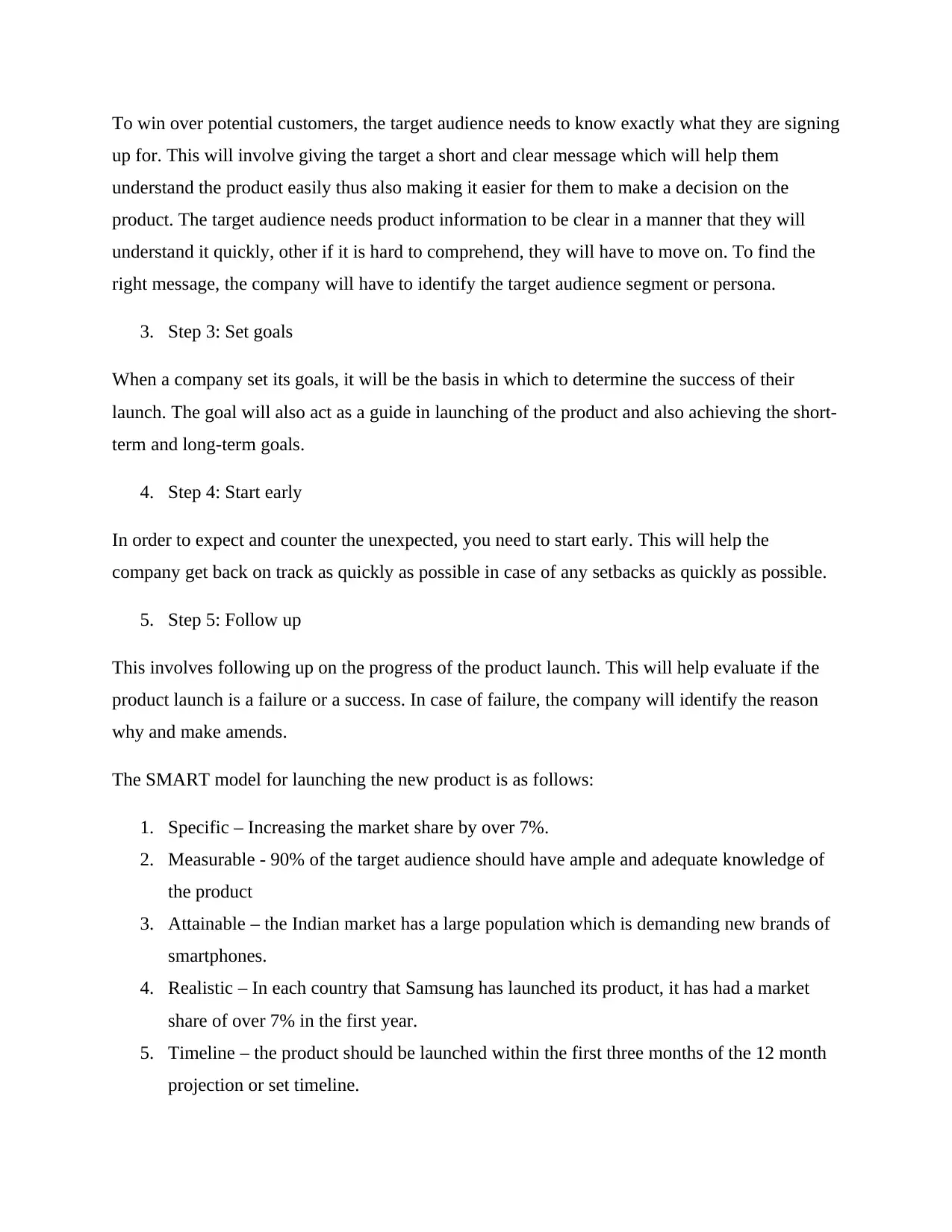
To win over potential customers, the target audience needs to know exactly what they are signing
up for. This will involve giving the target a short and clear message which will help them
understand the product easily thus also making it easier for them to make a decision on the
product. The target audience needs product information to be clear in a manner that they will
understand it quickly, other if it is hard to comprehend, they will have to move on. To find the
right message, the company will have to identify the target audience segment or persona.
3. Step 3: Set goals
When a company set its goals, it will be the basis in which to determine the success of their
launch. The goal will also act as a guide in launching of the product and also achieving the short-
term and long-term goals.
4. Step 4: Start early
In order to expect and counter the unexpected, you need to start early. This will help the
company get back on track as quickly as possible in case of any setbacks as quickly as possible.
5. Step 5: Follow up
This involves following up on the progress of the product launch. This will help evaluate if the
product launch is a failure or a success. In case of failure, the company will identify the reason
why and make amends.
The SMART model for launching the new product is as follows:
1. Specific – Increasing the market share by over 7%.
2. Measurable - 90% of the target audience should have ample and adequate knowledge of
the product
3. Attainable – the Indian market has a large population which is demanding new brands of
smartphones.
4. Realistic – In each country that Samsung has launched its product, it has had a market
share of over 7% in the first year.
5. Timeline – the product should be launched within the first three months of the 12 month
projection or set timeline.
up for. This will involve giving the target a short and clear message which will help them
understand the product easily thus also making it easier for them to make a decision on the
product. The target audience needs product information to be clear in a manner that they will
understand it quickly, other if it is hard to comprehend, they will have to move on. To find the
right message, the company will have to identify the target audience segment or persona.
3. Step 3: Set goals
When a company set its goals, it will be the basis in which to determine the success of their
launch. The goal will also act as a guide in launching of the product and also achieving the short-
term and long-term goals.
4. Step 4: Start early
In order to expect and counter the unexpected, you need to start early. This will help the
company get back on track as quickly as possible in case of any setbacks as quickly as possible.
5. Step 5: Follow up
This involves following up on the progress of the product launch. This will help evaluate if the
product launch is a failure or a success. In case of failure, the company will identify the reason
why and make amends.
The SMART model for launching the new product is as follows:
1. Specific – Increasing the market share by over 7%.
2. Measurable - 90% of the target audience should have ample and adequate knowledge of
the product
3. Attainable – the Indian market has a large population which is demanding new brands of
smartphones.
4. Realistic – In each country that Samsung has launched its product, it has had a market
share of over 7% in the first year.
5. Timeline – the product should be launched within the first three months of the 12 month
projection or set timeline.
Paraphrase This Document
Need a fresh take? Get an instant paraphrase of this document with our AI Paraphraser
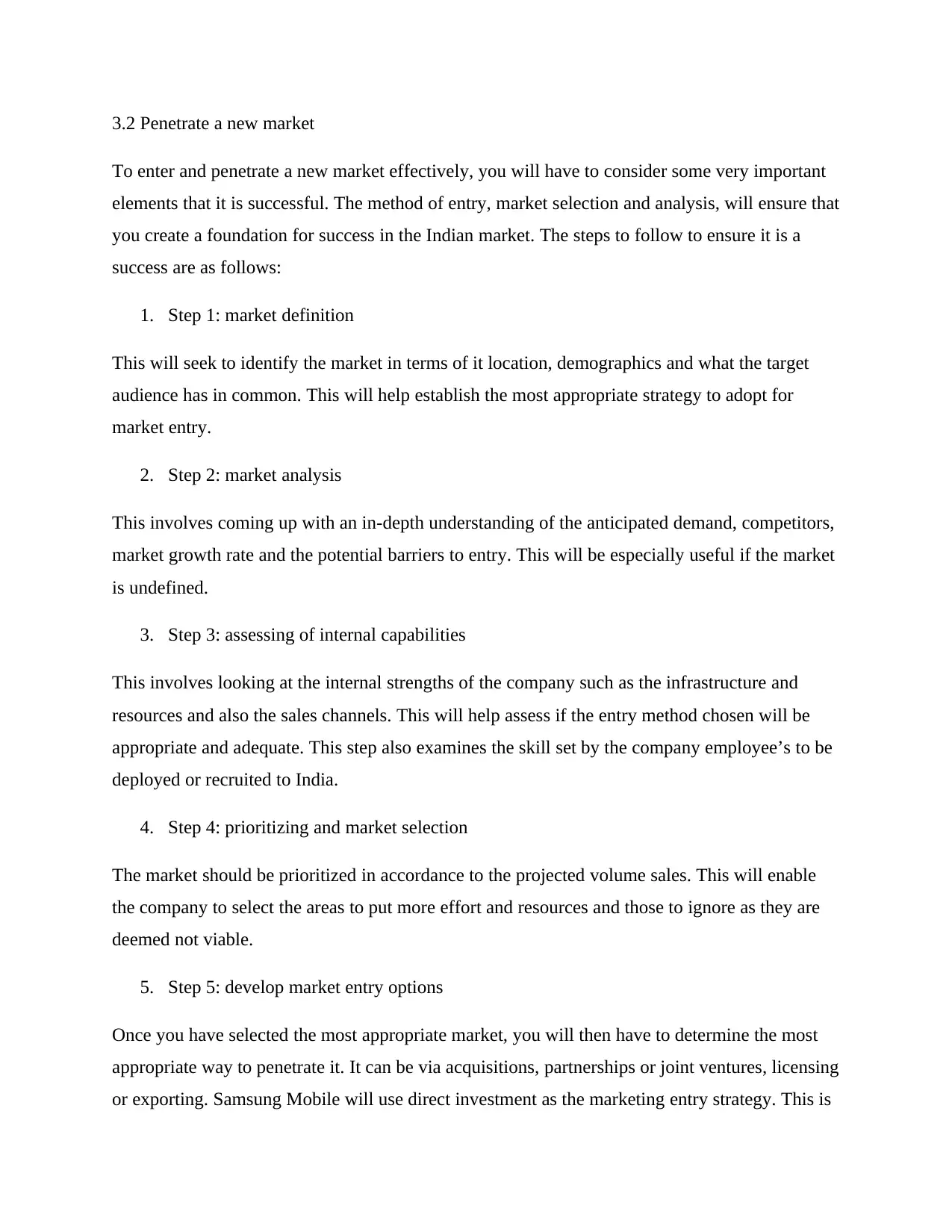
3.2 Penetrate a new market
To enter and penetrate a new market effectively, you will have to consider some very important
elements that it is successful. The method of entry, market selection and analysis, will ensure that
you create a foundation for success in the Indian market. The steps to follow to ensure it is a
success are as follows:
1. Step 1: market definition
This will seek to identify the market in terms of it location, demographics and what the target
audience has in common. This will help establish the most appropriate strategy to adopt for
market entry.
2. Step 2: market analysis
This involves coming up with an in-depth understanding of the anticipated demand, competitors,
market growth rate and the potential barriers to entry. This will be especially useful if the market
is undefined.
3. Step 3: assessing of internal capabilities
This involves looking at the internal strengths of the company such as the infrastructure and
resources and also the sales channels. This will help assess if the entry method chosen will be
appropriate and adequate. This step also examines the skill set by the company employee’s to be
deployed or recruited to India.
4. Step 4: prioritizing and market selection
The market should be prioritized in accordance to the projected volume sales. This will enable
the company to select the areas to put more effort and resources and those to ignore as they are
deemed not viable.
5. Step 5: develop market entry options
Once you have selected the most appropriate market, you will then have to determine the most
appropriate way to penetrate it. It can be via acquisitions, partnerships or joint ventures, licensing
or exporting. Samsung Mobile will use direct investment as the marketing entry strategy. This is
To enter and penetrate a new market effectively, you will have to consider some very important
elements that it is successful. The method of entry, market selection and analysis, will ensure that
you create a foundation for success in the Indian market. The steps to follow to ensure it is a
success are as follows:
1. Step 1: market definition
This will seek to identify the market in terms of it location, demographics and what the target
audience has in common. This will help establish the most appropriate strategy to adopt for
market entry.
2. Step 2: market analysis
This involves coming up with an in-depth understanding of the anticipated demand, competitors,
market growth rate and the potential barriers to entry. This will be especially useful if the market
is undefined.
3. Step 3: assessing of internal capabilities
This involves looking at the internal strengths of the company such as the infrastructure and
resources and also the sales channels. This will help assess if the entry method chosen will be
appropriate and adequate. This step also examines the skill set by the company employee’s to be
deployed or recruited to India.
4. Step 4: prioritizing and market selection
The market should be prioritized in accordance to the projected volume sales. This will enable
the company to select the areas to put more effort and resources and those to ignore as they are
deemed not viable.
5. Step 5: develop market entry options
Once you have selected the most appropriate market, you will then have to determine the most
appropriate way to penetrate it. It can be via acquisitions, partnerships or joint ventures, licensing
or exporting. Samsung Mobile will use direct investment as the marketing entry strategy. This is
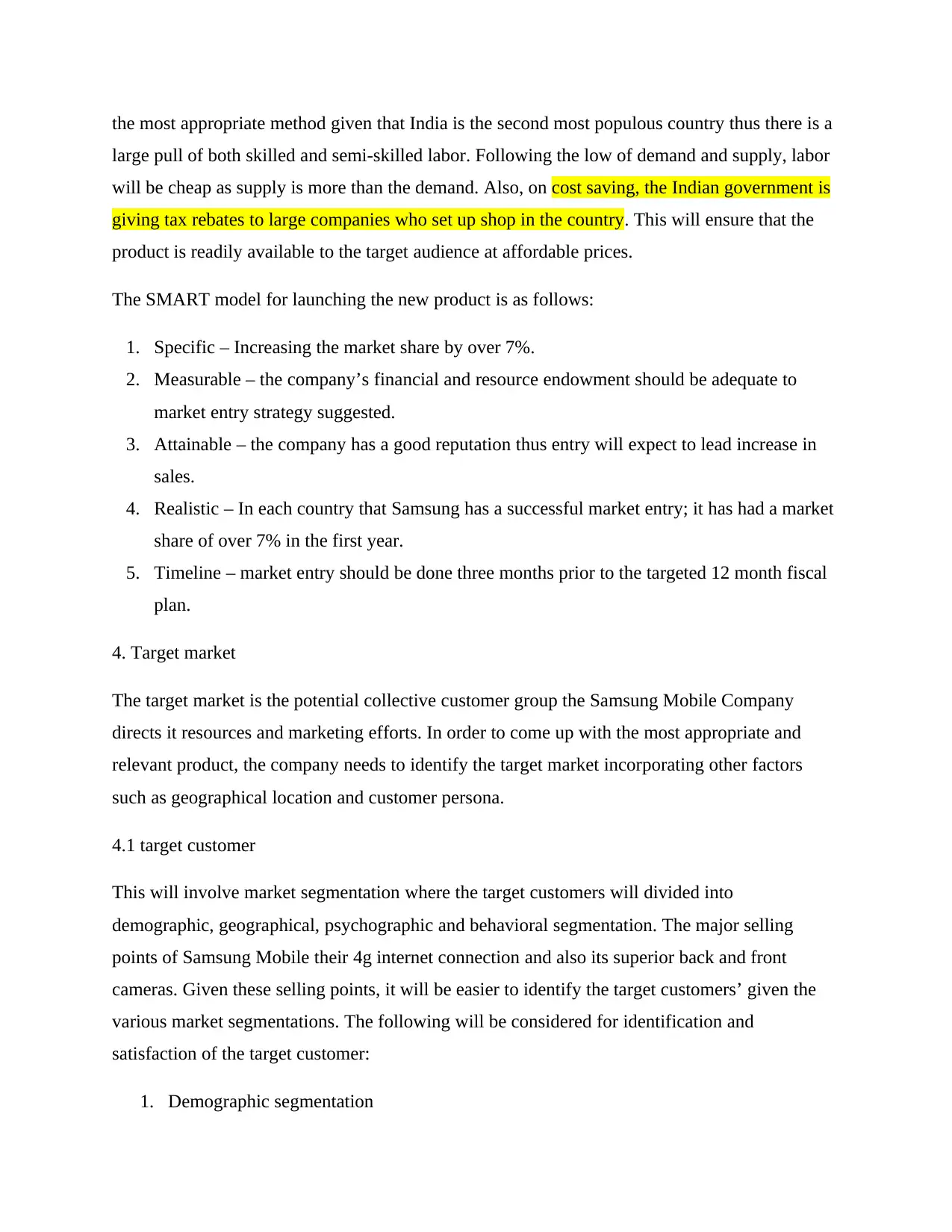
the most appropriate method given that India is the second most populous country thus there is a
large pull of both skilled and semi-skilled labor. Following the low of demand and supply, labor
will be cheap as supply is more than the demand. Also, on cost saving, the Indian government is
giving tax rebates to large companies who set up shop in the country. This will ensure that the
product is readily available to the target audience at affordable prices.
The SMART model for launching the new product is as follows:
1. Specific – Increasing the market share by over 7%.
2. Measurable – the company’s financial and resource endowment should be adequate to
market entry strategy suggested.
3. Attainable – the company has a good reputation thus entry will expect to lead increase in
sales.
4. Realistic – In each country that Samsung has a successful market entry; it has had a market
share of over 7% in the first year.
5. Timeline – market entry should be done three months prior to the targeted 12 month fiscal
plan.
4. Target market
The target market is the potential collective customer group the Samsung Mobile Company
directs it resources and marketing efforts. In order to come up with the most appropriate and
relevant product, the company needs to identify the target market incorporating other factors
such as geographical location and customer persona.
4.1 target customer
This will involve market segmentation where the target customers will divided into
demographic, geographical, psychographic and behavioral segmentation. The major selling
points of Samsung Mobile their 4g internet connection and also its superior back and front
cameras. Given these selling points, it will be easier to identify the target customers’ given the
various market segmentations. The following will be considered for identification and
satisfaction of the target customer:
1. Demographic segmentation
large pull of both skilled and semi-skilled labor. Following the low of demand and supply, labor
will be cheap as supply is more than the demand. Also, on cost saving, the Indian government is
giving tax rebates to large companies who set up shop in the country. This will ensure that the
product is readily available to the target audience at affordable prices.
The SMART model for launching the new product is as follows:
1. Specific – Increasing the market share by over 7%.
2. Measurable – the company’s financial and resource endowment should be adequate to
market entry strategy suggested.
3. Attainable – the company has a good reputation thus entry will expect to lead increase in
sales.
4. Realistic – In each country that Samsung has a successful market entry; it has had a market
share of over 7% in the first year.
5. Timeline – market entry should be done three months prior to the targeted 12 month fiscal
plan.
4. Target market
The target market is the potential collective customer group the Samsung Mobile Company
directs it resources and marketing efforts. In order to come up with the most appropriate and
relevant product, the company needs to identify the target market incorporating other factors
such as geographical location and customer persona.
4.1 target customer
This will involve market segmentation where the target customers will divided into
demographic, geographical, psychographic and behavioral segmentation. The major selling
points of Samsung Mobile their 4g internet connection and also its superior back and front
cameras. Given these selling points, it will be easier to identify the target customers’ given the
various market segmentations. The following will be considered for identification and
satisfaction of the target customer:
1. Demographic segmentation
⊘ This is a preview!⊘
Do you want full access?
Subscribe today to unlock all pages.

Trusted by 1+ million students worldwide
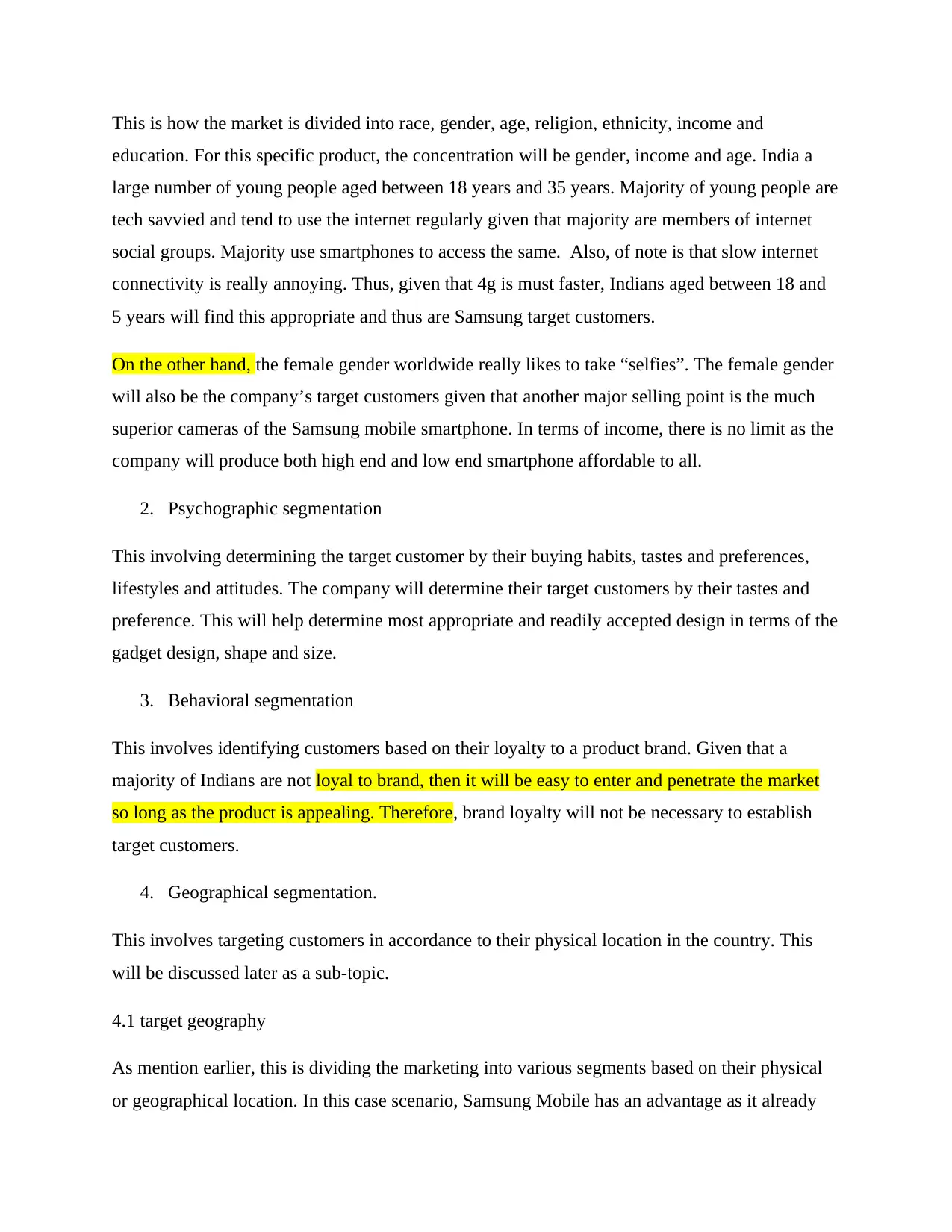
This is how the market is divided into race, gender, age, religion, ethnicity, income and
education. For this specific product, the concentration will be gender, income and age. India a
large number of young people aged between 18 years and 35 years. Majority of young people are
tech savvied and tend to use the internet regularly given that majority are members of internet
social groups. Majority use smartphones to access the same. Also, of note is that slow internet
connectivity is really annoying. Thus, given that 4g is must faster, Indians aged between 18 and
5 years will find this appropriate and thus are Samsung target customers.
On the other hand, the female gender worldwide really likes to take “selfies”. The female gender
will also be the company’s target customers given that another major selling point is the much
superior cameras of the Samsung mobile smartphone. In terms of income, there is no limit as the
company will produce both high end and low end smartphone affordable to all.
2. Psychographic segmentation
This involving determining the target customer by their buying habits, tastes and preferences,
lifestyles and attitudes. The company will determine their target customers by their tastes and
preference. This will help determine most appropriate and readily accepted design in terms of the
gadget design, shape and size.
3. Behavioral segmentation
This involves identifying customers based on their loyalty to a product brand. Given that a
majority of Indians are not loyal to brand, then it will be easy to enter and penetrate the market
so long as the product is appealing. Therefore, brand loyalty will not be necessary to establish
target customers.
4. Geographical segmentation.
This involves targeting customers in accordance to their physical location in the country. This
will be discussed later as a sub-topic.
4.1 target geography
As mention earlier, this is dividing the marketing into various segments based on their physical
or geographical location. In this case scenario, Samsung Mobile has an advantage as it already
education. For this specific product, the concentration will be gender, income and age. India a
large number of young people aged between 18 years and 35 years. Majority of young people are
tech savvied and tend to use the internet regularly given that majority are members of internet
social groups. Majority use smartphones to access the same. Also, of note is that slow internet
connectivity is really annoying. Thus, given that 4g is must faster, Indians aged between 18 and
5 years will find this appropriate and thus are Samsung target customers.
On the other hand, the female gender worldwide really likes to take “selfies”. The female gender
will also be the company’s target customers given that another major selling point is the much
superior cameras of the Samsung mobile smartphone. In terms of income, there is no limit as the
company will produce both high end and low end smartphone affordable to all.
2. Psychographic segmentation
This involving determining the target customer by their buying habits, tastes and preferences,
lifestyles and attitudes. The company will determine their target customers by their tastes and
preference. This will help determine most appropriate and readily accepted design in terms of the
gadget design, shape and size.
3. Behavioral segmentation
This involves identifying customers based on their loyalty to a product brand. Given that a
majority of Indians are not loyal to brand, then it will be easy to enter and penetrate the market
so long as the product is appealing. Therefore, brand loyalty will not be necessary to establish
target customers.
4. Geographical segmentation.
This involves targeting customers in accordance to their physical location in the country. This
will be discussed later as a sub-topic.
4.1 target geography
As mention earlier, this is dividing the marketing into various segments based on their physical
or geographical location. In this case scenario, Samsung Mobile has an advantage as it already
Paraphrase This Document
Need a fresh take? Get an instant paraphrase of this document with our AI Paraphraser
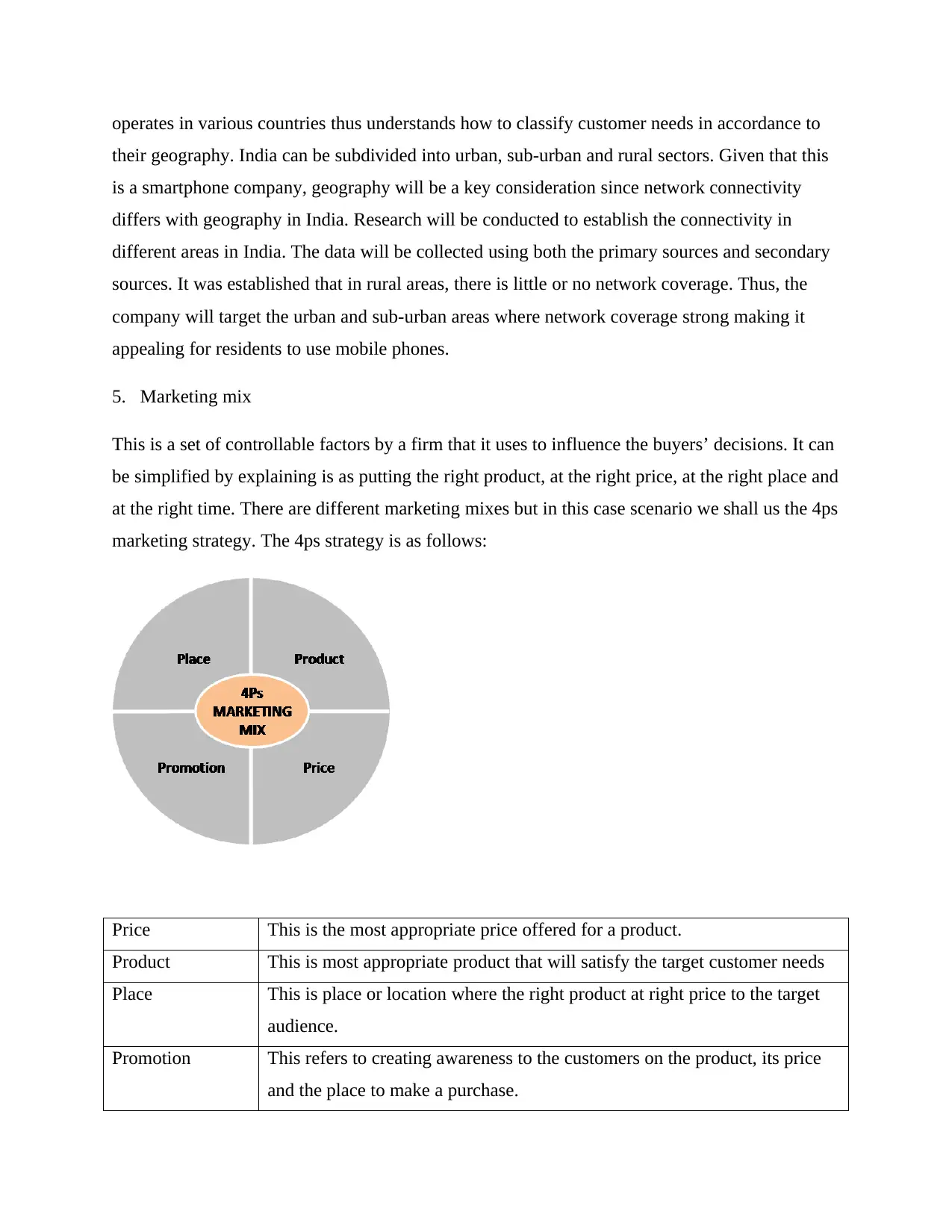
operates in various countries thus understands how to classify customer needs in accordance to
their geography. India can be subdivided into urban, sub-urban and rural sectors. Given that this
is a smartphone company, geography will be a key consideration since network connectivity
differs with geography in India. Research will be conducted to establish the connectivity in
different areas in India. The data will be collected using both the primary sources and secondary
sources. It was established that in rural areas, there is little or no network coverage. Thus, the
company will target the urban and sub-urban areas where network coverage strong making it
appealing for residents to use mobile phones.
5. Marketing mix
This is a set of controllable factors by a firm that it uses to influence the buyers’ decisions. It can
be simplified by explaining is as putting the right product, at the right price, at the right place and
at the right time. There are different marketing mixes but in this case scenario we shall us the 4ps
marketing strategy. The 4ps strategy is as follows:
Price This is the most appropriate price offered for a product.
Product This is most appropriate product that will satisfy the target customer needs
Place This is place or location where the right product at right price to the target
audience.
Promotion This refers to creating awareness to the customers on the product, its price
and the place to make a purchase.
their geography. India can be subdivided into urban, sub-urban and rural sectors. Given that this
is a smartphone company, geography will be a key consideration since network connectivity
differs with geography in India. Research will be conducted to establish the connectivity in
different areas in India. The data will be collected using both the primary sources and secondary
sources. It was established that in rural areas, there is little or no network coverage. Thus, the
company will target the urban and sub-urban areas where network coverage strong making it
appealing for residents to use mobile phones.
5. Marketing mix
This is a set of controllable factors by a firm that it uses to influence the buyers’ decisions. It can
be simplified by explaining is as putting the right product, at the right price, at the right place and
at the right time. There are different marketing mixes but in this case scenario we shall us the 4ps
marketing strategy. The 4ps strategy is as follows:
Price This is the most appropriate price offered for a product.
Product This is most appropriate product that will satisfy the target customer needs
Place This is place or location where the right product at right price to the target
audience.
Promotion This refers to creating awareness to the customers on the product, its price
and the place to make a purchase.
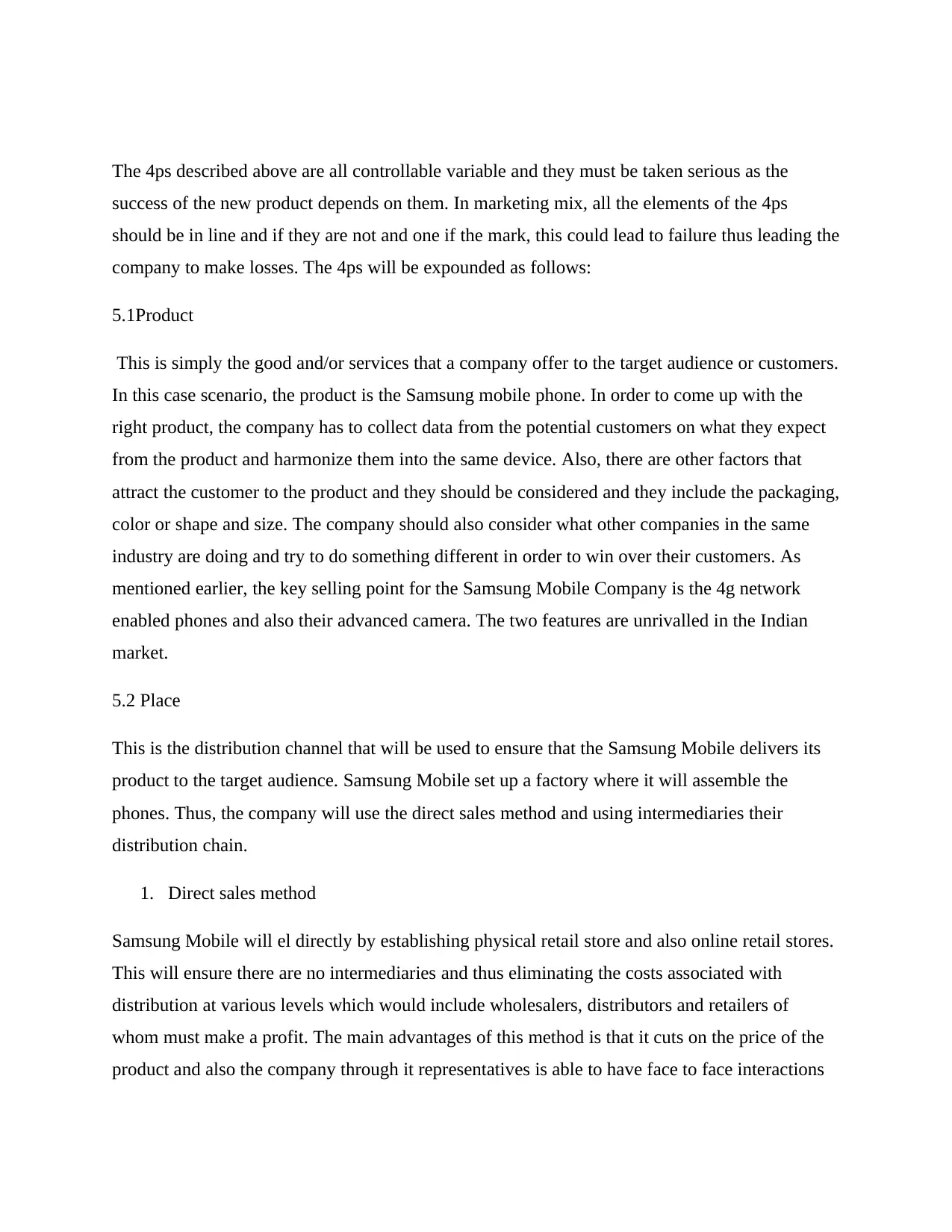
The 4ps described above are all controllable variable and they must be taken serious as the
success of the new product depends on them. In marketing mix, all the elements of the 4ps
should be in line and if they are not and one if the mark, this could lead to failure thus leading the
company to make losses. The 4ps will be expounded as follows:
5.1Product
This is simply the good and/or services that a company offer to the target audience or customers.
In this case scenario, the product is the Samsung mobile phone. In order to come up with the
right product, the company has to collect data from the potential customers on what they expect
from the product and harmonize them into the same device. Also, there are other factors that
attract the customer to the product and they should be considered and they include the packaging,
color or shape and size. The company should also consider what other companies in the same
industry are doing and try to do something different in order to win over their customers. As
mentioned earlier, the key selling point for the Samsung Mobile Company is the 4g network
enabled phones and also their advanced camera. The two features are unrivalled in the Indian
market.
5.2 Place
This is the distribution channel that will be used to ensure that the Samsung Mobile delivers its
product to the target audience. Samsung Mobile set up a factory where it will assemble the
phones. Thus, the company will use the direct sales method and using intermediaries their
distribution chain.
1. Direct sales method
Samsung Mobile will el directly by establishing physical retail store and also online retail stores.
This will ensure there are no intermediaries and thus eliminating the costs associated with
distribution at various levels which would include wholesalers, distributors and retailers of
whom must make a profit. The main advantages of this method is that it cuts on the price of the
product and also the company through it representatives is able to have face to face interactions
success of the new product depends on them. In marketing mix, all the elements of the 4ps
should be in line and if they are not and one if the mark, this could lead to failure thus leading the
company to make losses. The 4ps will be expounded as follows:
5.1Product
This is simply the good and/or services that a company offer to the target audience or customers.
In this case scenario, the product is the Samsung mobile phone. In order to come up with the
right product, the company has to collect data from the potential customers on what they expect
from the product and harmonize them into the same device. Also, there are other factors that
attract the customer to the product and they should be considered and they include the packaging,
color or shape and size. The company should also consider what other companies in the same
industry are doing and try to do something different in order to win over their customers. As
mentioned earlier, the key selling point for the Samsung Mobile Company is the 4g network
enabled phones and also their advanced camera. The two features are unrivalled in the Indian
market.
5.2 Place
This is the distribution channel that will be used to ensure that the Samsung Mobile delivers its
product to the target audience. Samsung Mobile set up a factory where it will assemble the
phones. Thus, the company will use the direct sales method and using intermediaries their
distribution chain.
1. Direct sales method
Samsung Mobile will el directly by establishing physical retail store and also online retail stores.
This will ensure there are no intermediaries and thus eliminating the costs associated with
distribution at various levels which would include wholesalers, distributors and retailers of
whom must make a profit. The main advantages of this method is that it cuts on the price of the
product and also the company through it representatives is able to have face to face interactions
⊘ This is a preview!⊘
Do you want full access?
Subscribe today to unlock all pages.

Trusted by 1+ million students worldwide
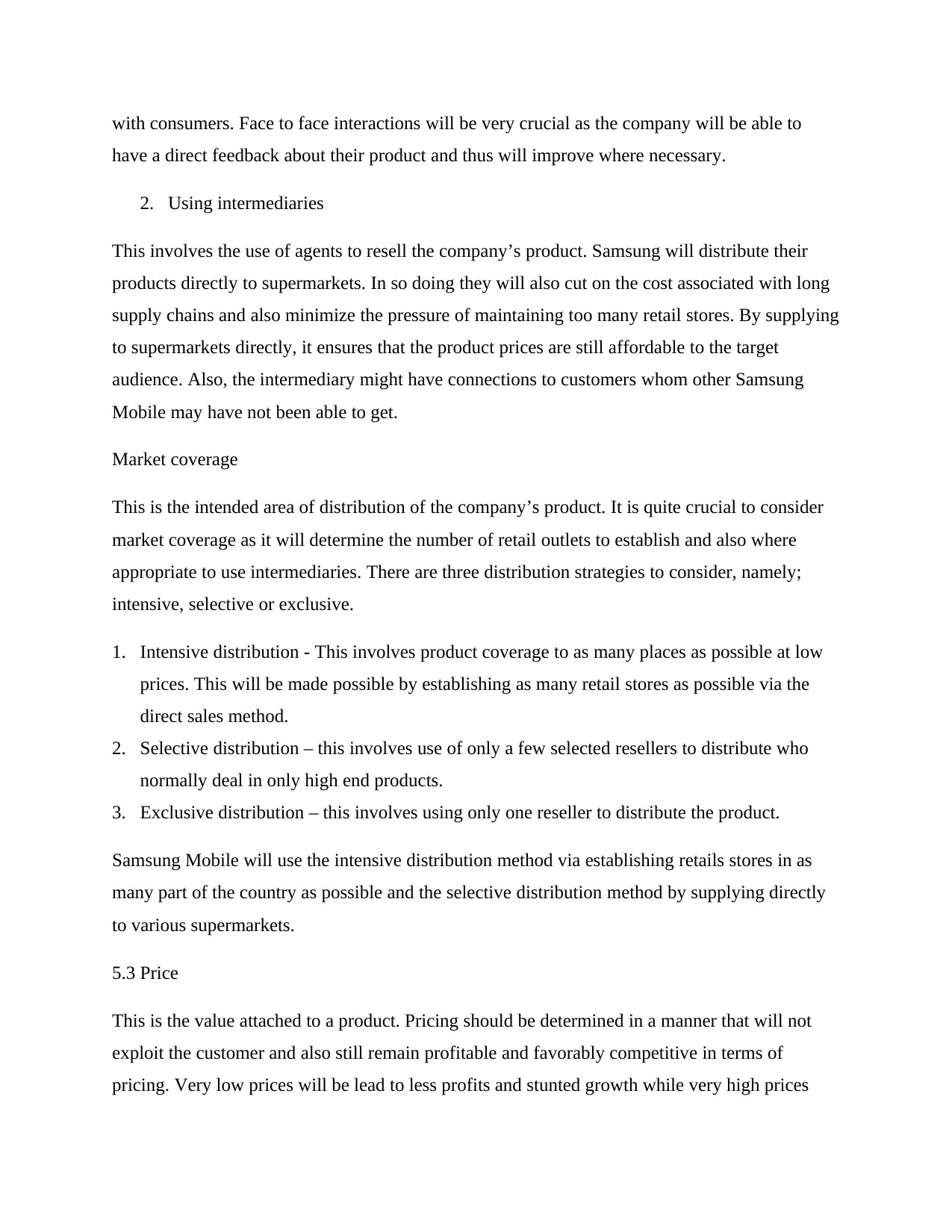
with consumers. Face to face interactions will be very crucial as the company will be able to
have a direct feedback about their product and thus will improve where necessary.
2. Using intermediaries
This involves the use of agents to resell the company’s product. Samsung will distribute their
products directly to supermarkets. In so doing they will also cut on the cost associated with long
supply chains and also minimize the pressure of maintaining too many retail stores. By supplying
to supermarkets directly, it ensures that the product prices are still affordable to the target
audience. Also, the intermediary might have connections to customers whom other Samsung
Mobile may have not been able to get.
Market coverage
This is the intended area of distribution of the company’s product. It is quite crucial to consider
market coverage as it will determine the number of retail outlets to establish and also where
appropriate to use intermediaries. There are three distribution strategies to consider, namely;
intensive, selective or exclusive.
1. Intensive distribution - This involves product coverage to as many places as possible at low
prices. This will be made possible by establishing as many retail stores as possible via the
direct sales method.
2. Selective distribution – this involves use of only a few selected resellers to distribute who
normally deal in only high end products.
3. Exclusive distribution – this involves using only one reseller to distribute the product.
Samsung Mobile will use the intensive distribution method via establishing retails stores in as
many part of the country as possible and the selective distribution method by supplying directly
to various supermarkets.
5.3 Price
This is the value attached to a product. Pricing should be determined in a manner that will not
exploit the customer and also still remain profitable and favorably competitive in terms of
pricing. Very low prices will be lead to less profits and stunted growth while very high prices
have a direct feedback about their product and thus will improve where necessary.
2. Using intermediaries
This involves the use of agents to resell the company’s product. Samsung will distribute their
products directly to supermarkets. In so doing they will also cut on the cost associated with long
supply chains and also minimize the pressure of maintaining too many retail stores. By supplying
to supermarkets directly, it ensures that the product prices are still affordable to the target
audience. Also, the intermediary might have connections to customers whom other Samsung
Mobile may have not been able to get.
Market coverage
This is the intended area of distribution of the company’s product. It is quite crucial to consider
market coverage as it will determine the number of retail outlets to establish and also where
appropriate to use intermediaries. There are three distribution strategies to consider, namely;
intensive, selective or exclusive.
1. Intensive distribution - This involves product coverage to as many places as possible at low
prices. This will be made possible by establishing as many retail stores as possible via the
direct sales method.
2. Selective distribution – this involves use of only a few selected resellers to distribute who
normally deal in only high end products.
3. Exclusive distribution – this involves using only one reseller to distribute the product.
Samsung Mobile will use the intensive distribution method via establishing retails stores in as
many part of the country as possible and the selective distribution method by supplying directly
to various supermarkets.
5.3 Price
This is the value attached to a product. Pricing should be determined in a manner that will not
exploit the customer and also still remain profitable and favorably competitive in terms of
pricing. Very low prices will be lead to less profits and stunted growth while very high prices
Paraphrase This Document
Need a fresh take? Get an instant paraphrase of this document with our AI Paraphraser
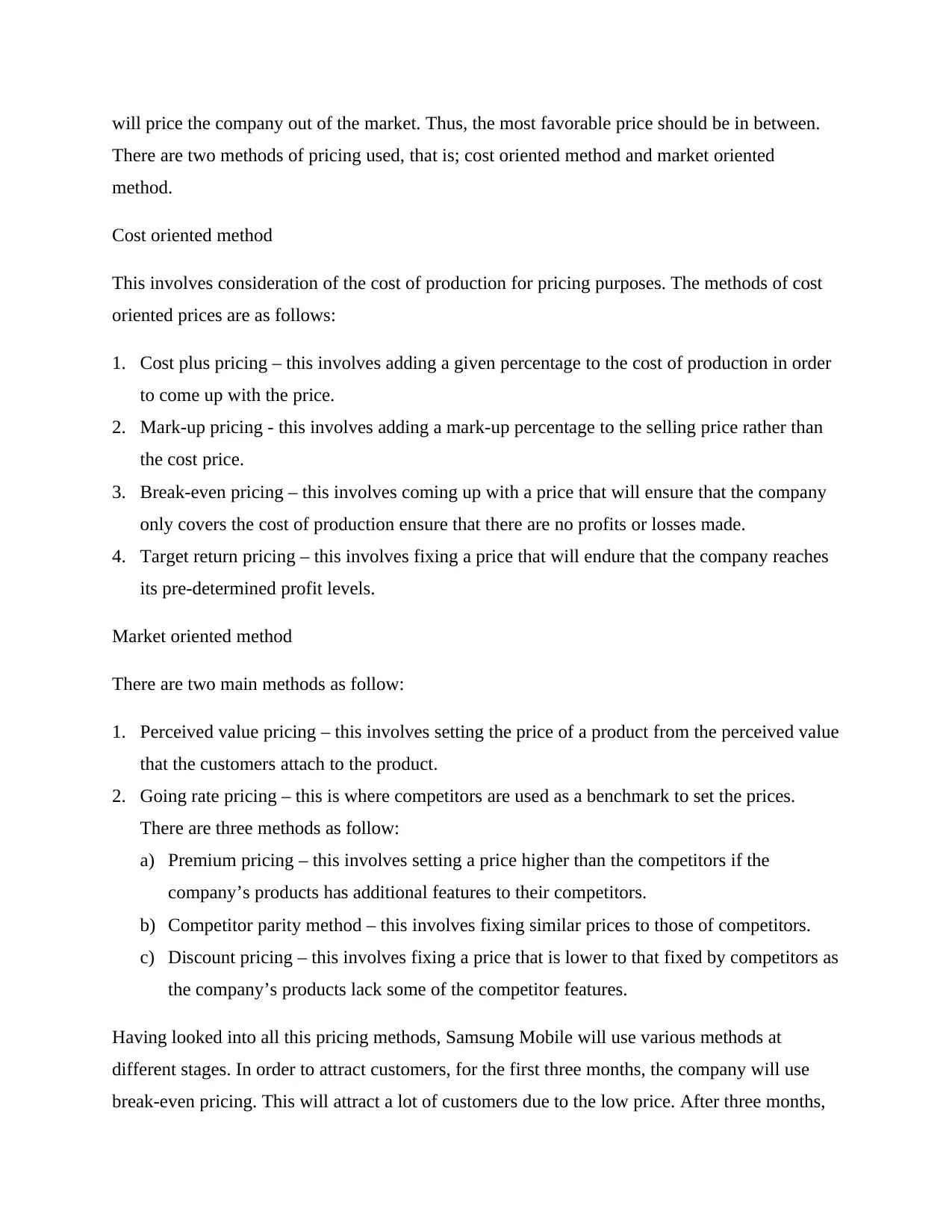
will price the company out of the market. Thus, the most favorable price should be in between.
There are two methods of pricing used, that is; cost oriented method and market oriented
method.
Cost oriented method
This involves consideration of the cost of production for pricing purposes. The methods of cost
oriented prices are as follows:
1. Cost plus pricing – this involves adding a given percentage to the cost of production in order
to come up with the price.
2. Mark-up pricing - this involves adding a mark-up percentage to the selling price rather than
the cost price.
3. Break-even pricing – this involves coming up with a price that will ensure that the company
only covers the cost of production ensure that there are no profits or losses made.
4. Target return pricing – this involves fixing a price that will endure that the company reaches
its pre-determined profit levels.
Market oriented method
There are two main methods as follow:
1. Perceived value pricing – this involves setting the price of a product from the perceived value
that the customers attach to the product.
2. Going rate pricing – this is where competitors are used as a benchmark to set the prices.
There are three methods as follow:
a) Premium pricing – this involves setting a price higher than the competitors if the
company’s products has additional features to their competitors.
b) Competitor parity method – this involves fixing similar prices to those of competitors.
c) Discount pricing – this involves fixing a price that is lower to that fixed by competitors as
the company’s products lack some of the competitor features.
Having looked into all this pricing methods, Samsung Mobile will use various methods at
different stages. In order to attract customers, for the first three months, the company will use
break-even pricing. This will attract a lot of customers due to the low price. After three months,
There are two methods of pricing used, that is; cost oriented method and market oriented
method.
Cost oriented method
This involves consideration of the cost of production for pricing purposes. The methods of cost
oriented prices are as follows:
1. Cost plus pricing – this involves adding a given percentage to the cost of production in order
to come up with the price.
2. Mark-up pricing - this involves adding a mark-up percentage to the selling price rather than
the cost price.
3. Break-even pricing – this involves coming up with a price that will ensure that the company
only covers the cost of production ensure that there are no profits or losses made.
4. Target return pricing – this involves fixing a price that will endure that the company reaches
its pre-determined profit levels.
Market oriented method
There are two main methods as follow:
1. Perceived value pricing – this involves setting the price of a product from the perceived value
that the customers attach to the product.
2. Going rate pricing – this is where competitors are used as a benchmark to set the prices.
There are three methods as follow:
a) Premium pricing – this involves setting a price higher than the competitors if the
company’s products has additional features to their competitors.
b) Competitor parity method – this involves fixing similar prices to those of competitors.
c) Discount pricing – this involves fixing a price that is lower to that fixed by competitors as
the company’s products lack some of the competitor features.
Having looked into all this pricing methods, Samsung Mobile will use various methods at
different stages. In order to attract customers, for the first three months, the company will use
break-even pricing. This will attract a lot of customers due to the low price. After three months,
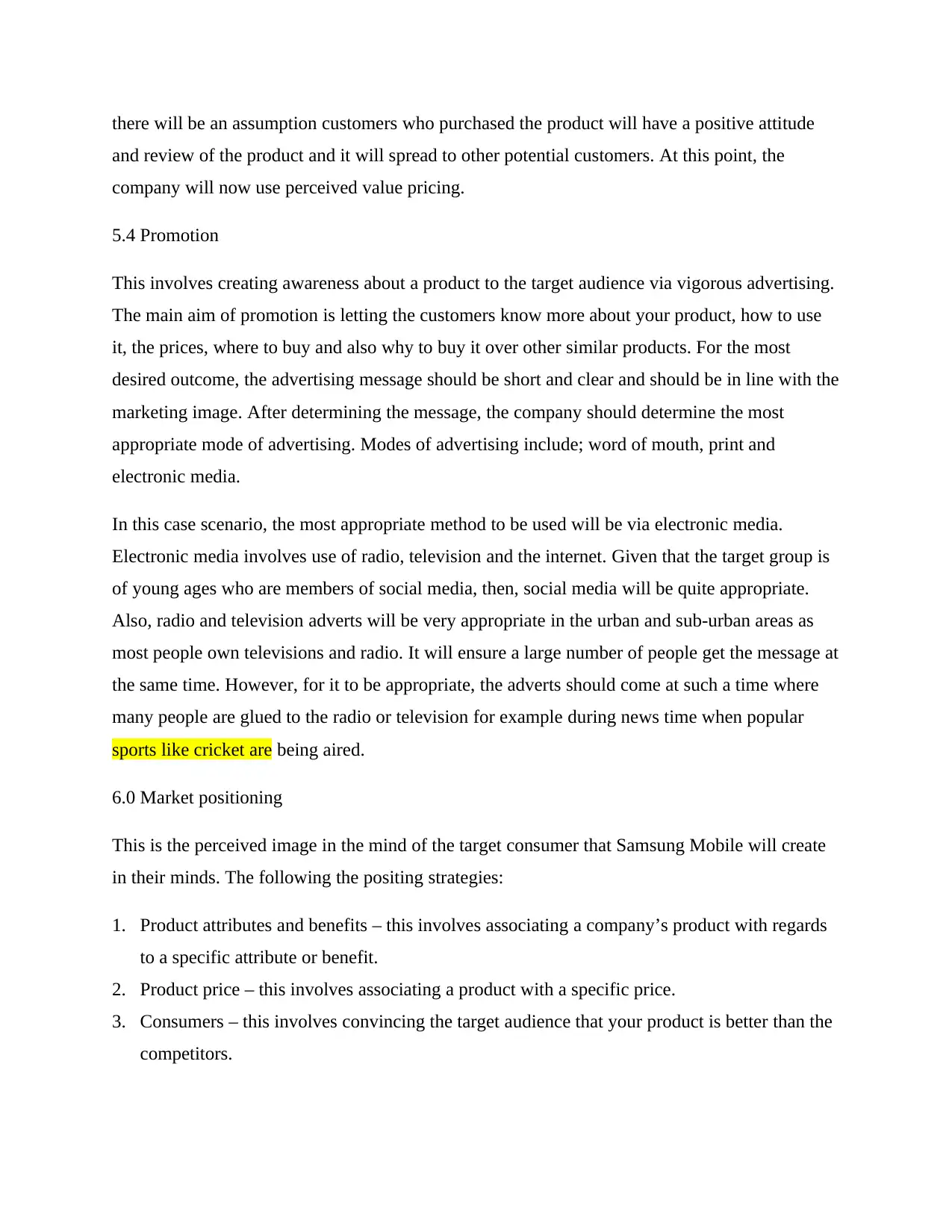
there will be an assumption customers who purchased the product will have a positive attitude
and review of the product and it will spread to other potential customers. At this point, the
company will now use perceived value pricing.
5.4 Promotion
This involves creating awareness about a product to the target audience via vigorous advertising.
The main aim of promotion is letting the customers know more about your product, how to use
it, the prices, where to buy and also why to buy it over other similar products. For the most
desired outcome, the advertising message should be short and clear and should be in line with the
marketing image. After determining the message, the company should determine the most
appropriate mode of advertising. Modes of advertising include; word of mouth, print and
electronic media.
In this case scenario, the most appropriate method to be used will be via electronic media.
Electronic media involves use of radio, television and the internet. Given that the target group is
of young ages who are members of social media, then, social media will be quite appropriate.
Also, radio and television adverts will be very appropriate in the urban and sub-urban areas as
most people own televisions and radio. It will ensure a large number of people get the message at
the same time. However, for it to be appropriate, the adverts should come at such a time where
many people are glued to the radio or television for example during news time when popular
sports like cricket are being aired.
6.0 Market positioning
This is the perceived image in the mind of the target consumer that Samsung Mobile will create
in their minds. The following the positing strategies:
1. Product attributes and benefits – this involves associating a company’s product with regards
to a specific attribute or benefit.
2. Product price – this involves associating a product with a specific price.
3. Consumers – this involves convincing the target audience that your product is better than the
competitors.
and review of the product and it will spread to other potential customers. At this point, the
company will now use perceived value pricing.
5.4 Promotion
This involves creating awareness about a product to the target audience via vigorous advertising.
The main aim of promotion is letting the customers know more about your product, how to use
it, the prices, where to buy and also why to buy it over other similar products. For the most
desired outcome, the advertising message should be short and clear and should be in line with the
marketing image. After determining the message, the company should determine the most
appropriate mode of advertising. Modes of advertising include; word of mouth, print and
electronic media.
In this case scenario, the most appropriate method to be used will be via electronic media.
Electronic media involves use of radio, television and the internet. Given that the target group is
of young ages who are members of social media, then, social media will be quite appropriate.
Also, radio and television adverts will be very appropriate in the urban and sub-urban areas as
most people own televisions and radio. It will ensure a large number of people get the message at
the same time. However, for it to be appropriate, the adverts should come at such a time where
many people are glued to the radio or television for example during news time when popular
sports like cricket are being aired.
6.0 Market positioning
This is the perceived image in the mind of the target consumer that Samsung Mobile will create
in their minds. The following the positing strategies:
1. Product attributes and benefits – this involves associating a company’s product with regards
to a specific attribute or benefit.
2. Product price – this involves associating a product with a specific price.
3. Consumers – this involves convincing the target audience that your product is better than the
competitors.
⊘ This is a preview!⊘
Do you want full access?
Subscribe today to unlock all pages.

Trusted by 1+ million students worldwide
1 out of 14
Related Documents
Your All-in-One AI-Powered Toolkit for Academic Success.
+13062052269
info@desklib.com
Available 24*7 on WhatsApp / Email
![[object Object]](/_next/static/media/star-bottom.7253800d.svg)
Unlock your academic potential
Copyright © 2020–2025 A2Z Services. All Rights Reserved. Developed and managed by ZUCOL.





